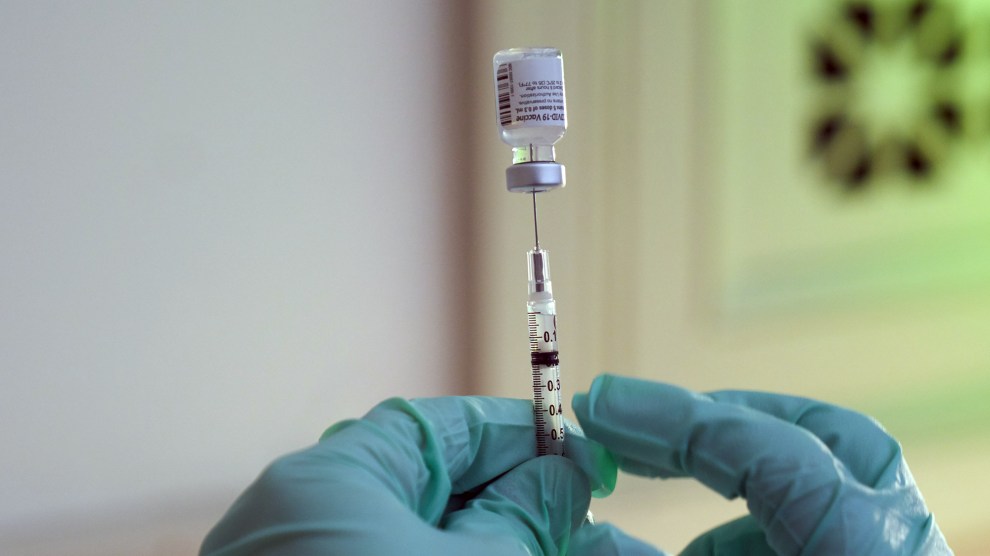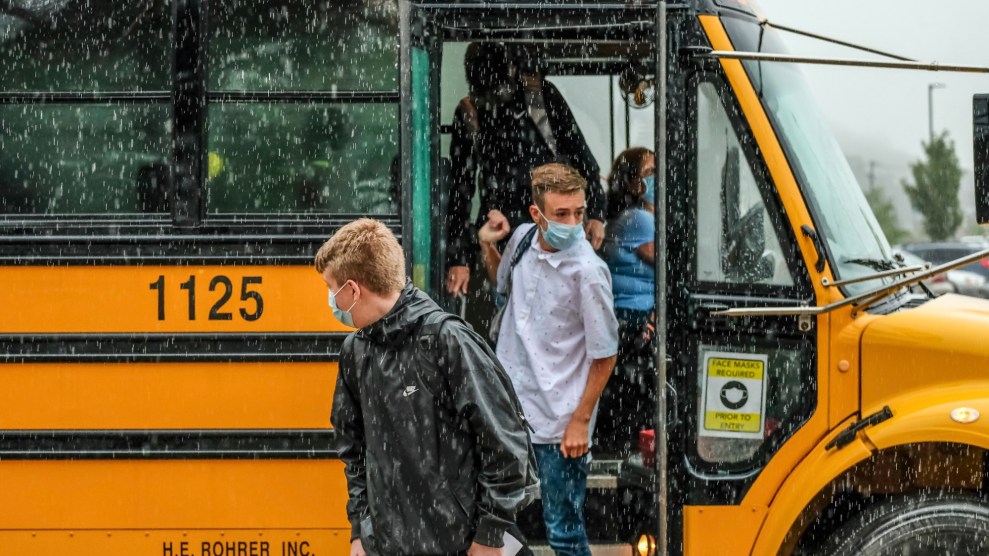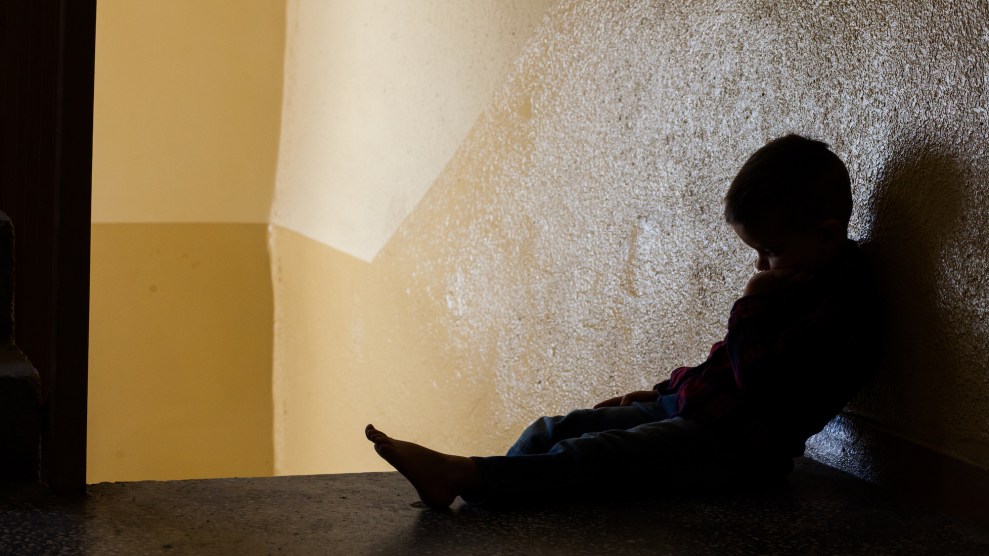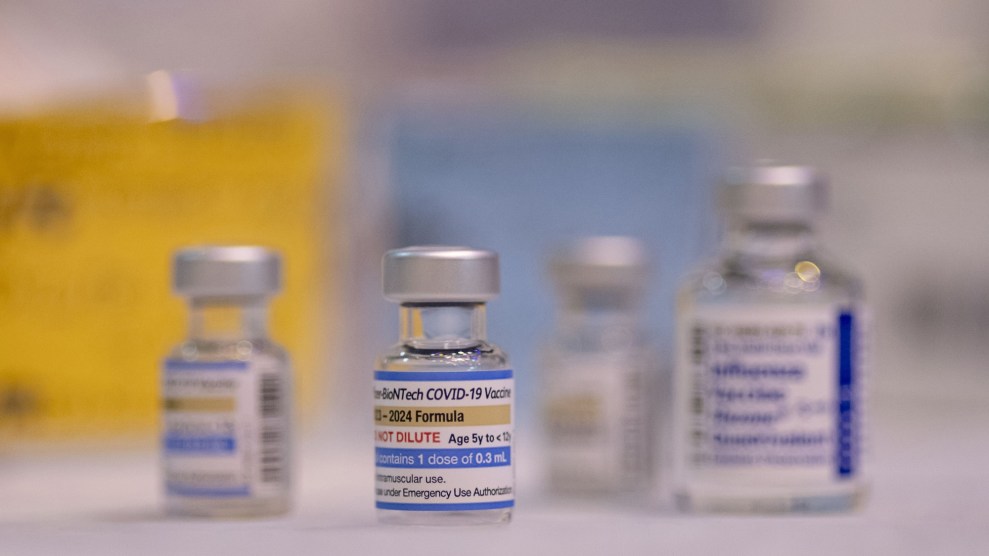
Allison Dinner/ZUMA
The weekend before Christmas was a busy one for the CDC’s Advisory Committee on Immunization Practices (ACIP). On Saturday, in an emergency session, they unanimously approved the second COVID vaccine, this one from Moderna. On Sunday, ACIP held another emergency session during which they attempted to resolve a subject of intense debate: namely, who would be included in the next phase of the CDC’s coronavirus vaccine distribution recommendations.
The advisory committee is made up of pediatricians, epidemiologists, and vaccinologists from across the country. They look at the scientific data from FDA vaccine trials and recommend who should get which vaccines, when and how they should get them, and then follow up with official written guidelines. They had already determined that the people at the front of the vaccine line, also known as Phase 1a, should be healthcare workers and long-term care facility workers, and they’ve already been injected with the first shipments of the Pfizer and Moderna vaccines. But who should be included in Phase 1b? On Sunday, they announced that frontline essential workers—first responders, food and agriculture workers, public transit workers, teachers and school workers— and people 75 years and older are up next.
“The goal of the ACIP is to provide recommendations that maximize benefit, minimize harm, that address inequality and disparity,” says José Romero, a pediatrician and the chair of CDC’s ACIP. Romero is also Arkansas’ Secretary of Health, meaning that he helps write the guidelines and implement them at the state level.
Teachers were not a shoe-in for the next phase of vaccinations. While they certainly play an important role in America’s social infrastructure, both as educators and childcare providers, throughout the debate about which Americans do and don’t count as “essential workers,” teachers have occupied ambiguous space. Some states, like Alabama and Arizona, designated teachers as essential workers in the early days of the pandemic. Other states, like New York, did not. Now, the rollout of the coronavirus vaccine has re-upped the questions and controversies surrounding the essential workers’ designation.

Right now, with 2.9 million doses of Pfizer’s vaccine and 6 million doses of Moderna’s vaccine sent out in the first shipments, the coronavirus vaccine is a scarce resource, and state and local public officials are the ones who must prioritize who gets the vaccine first. Vaccinating teachers and school could mean the beginning of the end school closures, which has been one of the most disruptive aspects of the pandemic. Public schools across the nation serve over 50 million children. Students across the country have spent most of the past year doing school in front of a screen, but studies and analyses have noted the potential long-term academic, emotional, social, and physical effects. TL;DR: they aren’t good.
Ricardo Colon is an instructional coach and teacher at PS/IS 30, a K-8 public school that’s home to about 900 students in Bay Ridge, Brooklyn. This year he’s teaching English Language Arts to two classes of seventh graders, with about 30 students in each class. Though Colon goes into the school building, his students’ classes have been virtual this year. Some of Colon’s middle schoolers get shy about turning their cameras on, which can be challenging for English language learners who rely on facial cues to understand what their classmates are saying.
“It was always awesome to just shut your computer, push everything to the side, and just walk into the classroom and enjoy the kids—to hear their conversations, to see a teacher genuinely at work promoting student discussion and student thought,” says Colon. “And that’s what I miss most.”
In-person schooling provides structure that is especially important for kids who are English-language learners or have Individualized Education Programs (IEPs). “I am worried that we might see some gaps that were widened a bit,” he says. The teachers and school staff at PS/IS 30 get tested once a week, and the school was forced to shut down for two weeks before Thanksgiving, and again the week before the winter holidays after staff tested positive for the virus.
Teachers across the country have balked against the pressure to return to their classrooms without appropriate safeguards, like access to PPE, frequent testing, and vaccinations. President Trump categorized teachers as essential workers last August in an effort to resume in-person education in the fall. In some states where teachers were forced to return to in-person teaching, like Tennessee and Florida, they were told that they should keep working after being exposed to the coronavirus instead of quarantining. Others participated in protests against unsafe in-person teaching and voiced concerns that teachers were being treated as “sacrificial.”
Can someone explain why teachers are not considered essential workers? https://t.co/T2Gyi4K8xa
— Joe Nocera (@opinion_joe) July 7, 2020
Randi Weingarten, the president of the American Federation of Teachers (AFT), says that she stopped using the term “essential workers” after it became so dangerously politicized by the Trump Administration. “Teachers have always been essential, whether or not there’s a moniker or nomenclature placed on them,” says Weingarten. “The way in which Trump and [Secretary of Education Betsy] DeVos politicized this issue made most of us completely distrustful of their motives and intentions, and their actions showed they were not to be trusted.”
According to an AFT survey conducted in June 2020, 76 percent of their members were comfortable with going back to in-person teaching if provided with the proper safeguards. But as teachers saw the way in which the Trump administration was handling the pandemic, their confidence dropped. Weingarten heard constantly from teachers, via text, email, phone calls, and town halls, that the Trump administration made them feel expendable. They saw how the CDC watered down their guidance for the safeguards necessary to reopen schools. They saw that schools were being told to reopen without receiving any resources to purchase the PPE or do the testing that would make it possible to reopen safely. So in August, when President Trump announced that the federal government was designating teachers as essential workers, the trust was already broken.
“Their push on this was for political reasons,” Weingarten says, “whether to polarize teachers versus parents, or whether it was because they wanted good economic numbers for Trump going into the election.”
Jen Kates from the Kaiser Family Foundation, who has been analyzing the vaccine distribution plans across all 50 states and D.C., explains that the CDC’s decision to include teachers in Phase 1b of the vaccine distribution will have a big impact on what states decide to do.
“When we did our review that was released last week,” Kates says, “some states had mentioned teachers, but they hadn’t gotten that specific yet because they were waiting to get more guidance from CDC.”
The ACIP has been giving advice on how to administer vaccines— from smallpox to rubella to influenza— since 1964, but this is the most highly anticipated mass vaccination campaign in history. Over 300,000 people in the United States have died from the coronavirus. Infection levels continue to climb at catastrophic rates with over 200,000 new cases reported in the last week. As Americans settle in for what is shaping up to to be the pandemic’s dark winter, the spread of the disease will get worse before it gets better. Not to mention the downstream toll the pandemic will continue to take on hospitals as beds and ICUs fill up with new COVID-19 patients. With so much hope pinned on coronavirus vaccines as the golden ticket out of the pandemic and back to some semblance of normalcy, ACIP’s routine work has come under intense scrutiny–and pressure. Romero has been lobbied by associations representing sheriffs, fire fighters, teachers, camp counselors, and mental health providers, who are all trying to ensure their members are as close to the front of the vaccine line as possible.
On November 30, a coalition of teachers’ unions sent a letter to Romero asking that adults working in schools be given “priority access to vaccinations.” Weingarten also sent a letter to Romero asking specifically that teachers and school workers be included in the 1b category.
“Our students need us to be back in the front of the classroom,” says E. Toby Boyd, president of the California Teachers Association (CTA). “That’s the best place for their educational experience, not only academically, but also socially, emotionally.”
California’s vaccine drafting guidelines working group has said that it is using four metrics to decide which professions get the vaccine first: societal impact, economic impact, equity, and occupational exposure. In the first two categories, teachers have a solid argument. Not only are they responsible for training the next generation to be kind, productive, and curious citizens, having children at home has also been seriously disruptive to parents in the workforce—especially women. The unemployment rate skyrocketed for everyone at the beginning of the coronavirus pandemic, but women were hit hardest of all, with their unemployment rate reaching a high of 15.7 percent in April 2020, hitting the double digits for the first time since 1948. This is partly because many women simply lost their jobs because of pandemic-related layoffs, but also because women bore the brunt of increased childcare duties with children home from school. These forces have led to this recession being known as a “she-cession.”
Weingarten and the Learning First Alliance letter have both pointed to another reason for vaccinating teachers early: schools could serve as vaccination sites. “Schools were vaccination sites for polio, for smallpox,” Weingarten says. “There’s no reason that we could not work with health facilities to do that here. And, frankly, schools are more trusted than most in terms of dealing with vaccine hesitancy.”
According to Kates from the Kaiser Family Foundation, the built-in infrastructure of schools will make this a more straightforward population to vaccinate. Teachers and school workers are an identifiable group with whom it’s easy to get in touch. Other groups, like those with high risk conditions, will be more difficult. This is an area that could be rife for abuse. For instance, the wealthy could use their means to get an advantageous diagnosis that could help them jump the line.
While the justifications for vaccinating teachers early were plentiful and ultimately persuasive, critics remain. Harvard epidemiologist Marc Lipsitch told The New York Times that teachers shouldn’t be prioritized for the vaccine because teachers “have middle-class salaries, are very often white, and they have college degrees.” Others suggest that if teachers are moved forward, other essential workers will necessarily be moved back. Truck drivers, for example, were relegated to Phase 1c.
Toby Boyd, the president of the California Teachers Association, emphasized that as important as the vaccine is, it’s only one piece of the puzzle. California—with one of the highest infection rates per capita in US—is a state where infections are high and on the rise. Boyd says vaccinations will have to be supplemented by other safety measures, like frequent testing and social distancing. At the same time, he suggests that the process of reopening schools can present an opportunity to fix some of their systemic problems.
“They need smaller class sizes where they can sit six feet apart, ventilation where they can breathe in clean air, and robust testing in order for us to truly feel safe in the classrooms,” he says. “There are so many things that we can do to push the reset and say, okay, this is our chance to make it better.”
While making it into Phase 1b feels like a victory for Weingarten, she points out that it’s only the very first step toward getting schools reopened. Teachers are one group within the 30 million people in Phase 1b, which means that many logistical hurdles remain, including producing enough vaccines, getting them to people, and making them free and accessible. “None of those questions are answered; we still don’t have a national plan,” she says. “The fact that the vaccines got out to so many health care facilities in the last two weeks is remarkable, but that’s only the first step.”
Of course, states don’t have to listen to the CDC recommendations at all, and the inclusion of teachers in the essential workers category has been hotly contested throughout the pandemic. So what if states just refuse to cooperate?
“That is always a possibility,” says Romero. “But we will provide a scientific rationale based on the current epidemiology of the disease that will inform the governors, and hopefully convince them that our recommendations are sound and are the best way to deliver vaccine to the populations at high risk.”
Despite the complications and the risks, Colon is optimistic that in-person schooling will resume eventually, with the added benefit that he and his fellow teachers will bring the technological skill they’ve acquired over many months of remote teaching back to the classroom with them.
“There’s something about a vibrant school building that really makes makes someone want to be a teacher, ” Colon says. “It’s the relationships with the children, it’s the seeing them in the hallway. Those interactions weigh just as much as the learning that happens in the classroom.”


















